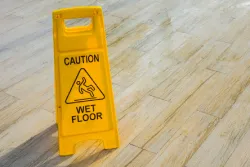Use of Signage and Barriers
Why Signage and Barriers Matter
As a security officer, you are more than just a visible presence on site — you are a guardian of safety. Slips, trips and falls are among the most common causes of workplace injury in the UK, making up over 30% of all reported incidents (HSE). One of the simplest yet most effective ways to reduce these risks is the correct use of signage and barriers.
Signs and barriers are not just “tick-box” items. When used correctly, they:

Warn people about hazards before they encounter them.
Control access to unsafe areas.
Demonstrate that your site takes health and safety seriously (important for compliance and liability).
Protect both staff and visitors, reducing the risk of injury and claims.
Remember, under the Health and Safety at Work Act 1974, everyone has a duty to protect others from harm. The proper use of signage and barriers helps you fulfil that duty.
Types of Signage and Barriers You’ll Encounter
As a security officer, you’ll often be the one who notices when a sign or barrier is needed — and sometimes the one who puts it in place. These tools might look simple, but when used correctly, they can prevent serious accidents. Let’s break them down:
Temporary floor signs – Think of the classic “Caution: Wet Floor” sign. Use these when there’s a spill, cleaning in progress, or rainwater at entrances. They warn people instantly and reduce the chance of slips.
Warning tape or cordons – Bright tape or cordons are perfect for marking off unsafe zones, such as a broken step, exposed wiring, or ongoing maintenance. They send a clear “do not enter” message.
Barrier stands or cones – These create a physical block to stop people entering a risky area, such as a wet stairwell or a damaged walkway. They’re especially useful in busy public spaces.
Permanent signage – Signs like “Fire Exit – Keep Clear” or “Mind the Step” must always remain visible and unobstructed. Part of your patrol is to make sure they haven’t been blocked, damaged, or ignored.
Quick tip for patrols: Place temporary signs before the hazard so people see the warning in time. A sign hidden behind a door, placed after the spill, or facing the wrong way is as good as no sign at all.
Real-World Example
You’re patrolling a shopping centre on a rainy day. A puddle has formed near the main entrance where customers are walking in with wet shoes.
If no signage or barriers are used: A customer could slip, fall, and make a claim against the centre. CCTV would show that no visible warning was given.
If signage and barriers are used: You place a “Wet Floor” cone clearly in the area, call cleaning staff, and stand by until the area is safe. Visitors immediately see the warning and adjust their path.
This simple action protects people, shows professionalism, and prevents the business from facing reputational or legal damage.
Common Mistakes to Avoid
Even well-meaning officers can misuse signage and barriers. Watch out for these frequent errors:
Leaving signs up after a hazard is gone — causes confusion and makes people ignore warnings.
Placing barriers in the wrong spot — for example, blocking the wrong entrance while the hazard remains open.
Overuse of signs — too many signs create “warning fatigue” and people stop paying attention.
Dirty, damaged, or unreadable signage — looks unprofessional and reduces effectiveness.
Always treat signage as a living tool, not just decoration.
Key Considerations for Officers
When dealing with signage and barriers, ask yourself:
Is the sign or barrier visible and easy to understand?
Is it in the right place? A wet floor cone in the corner won’t protect anyone if the hazard is in the middle of the walkway.
Has the hazard been removed as soon as possible? Signage warns, but it doesn’t fix the problem.
Have I logged my actions? Recording that you placed a barrier or signage protects you if an incident is investigated later.
Best Practice in Action
Imagine you are completing your patrol and you spot a leak dripping onto the floor in a busy corridor. Here’s what best practice looks like step by step:
Assess — identify the hazard and how serious it is.
Act — place signage and, if necessary, barriers immediately.
Report — contact cleaning/maintenance teams.
Monitor — stay nearby if the hazard is high risk until resolved.
Record — log all actions in your Daily Occurrence Book (DOB).
Following this process every time builds consistency, protects people, and demonstrates professionalism.
Poor vs Good Use of Signage
| Poor Use | Good Use |
|---|---|
| “Wet Floor” sign placed behind a bin where no one can see it. | “Wet Floor” sign placed directly in front of the hazard, visible from both directions. |
| Barrier tape half-hanging and creating a trip hazard. | Barrier stands placed securely across the unsafe area, leaving no access route. |
| Leaving a cone in place for days even when the floor is dry. | Removing signage promptly once the hazard is cleared. |
Tips for Best Practice
Use clear, recognised symbols and wording. Remember: not everyone speaks fluent English, but symbols are universal.
Place signage before people reach the hazard — not after.
Double-check that barriers are secure and won’t topple over or create new hazards.
Remove signage as soon as the hazard has been dealt with — unnecessary signs can cause confusion or complacency.
Always report faulty or missing signage to your supervisor or facilities team.
Consequences of Poor Use
If signage and barriers are not used properly:
For people: Increased risk of injury from slips, trips and falls.
For the business: Potential legal claims, fines, or enforcement action under health and safety law.
For you: Questions about your professionalism, risk to your SIA licence, and even disciplinary action if negligence is proven.
Scenario for Practice
Imagine you are patrolling a large office block and notice that one of the stairwells is being mopped, but no warning signs have been placed.
What should you do immediately?
Who should you inform?
How would you record this in your daily occurrence book (DOB) or incident report?
Think about how your actions protect people, the business, and yourself.
The Bottom Line for Officers
Signs and barriers might look like simple bits of plastic or tape, but in reality they’re lifesaving tools. They are your first line of defence against slips, trips, and falls — hazards that remain the leading cause of workplace injury in the UK. When you place a barrier or sign correctly, you’re not just following procedure, you’re actively preventing harm.
Think of it this way: every time you check that a fire exit sign is visible, place a cone over a wet floor, or cordon off a broken step, you’re taking direct action that protects staff, visitors, and contractors. You’re also safeguarding the business from costly claims and protecting your own SIA licence by showing professionalism and diligence.
Key reminder: Don’t treat signage and barriers as “tick-box tasks.” Treat them as part of your patrol toolkit. Use them promptly, position them smartly, and remove them when the hazard has been dealt with.
See it. Sign it. Secure it. – and you’ll not only keep people safe but also show the value of having skilled, proactive security officers on site.

